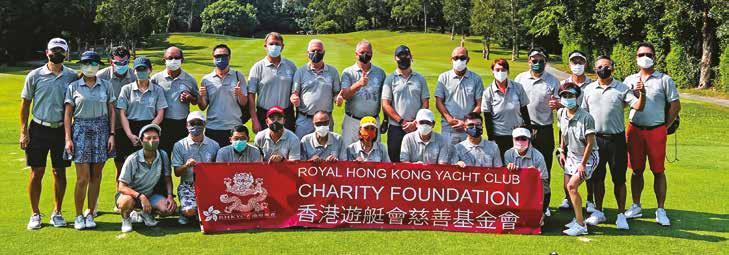
4 minute read
On the Horizon
from Ahoy! September 2022
by Koko Mueller
WORDS AND IMAGES: DON DAY
“This must be the only natural sloping coastline left in the central harbour!” – It was a surprised, interested and enthusiastic remark after a compass room lunch that triggered the first dive of “Kellett North”.
Advertisement
ellett Diving Society’s first dive strengthened our relationship with Dr. Andy Cornish, programme leader of WWF’s global shark and ray conservation programme (and speaker at the RHKYC as far back as 2013).
Andy and I (RHKYC Scuba Convenor and Hong Kong Ambassador of leading shark conversation NGO Shark Guardian), had met in January for a lunch and catch-up. While walking back on the balcony, observing the great visibility and sloping rock formation, we decided then and there to dive this site.
Pandemic restrictions delayed the dive, and we wanted to wait for improved visibility (and warmer water temperatures!) in spring. Having picked up tanks early in the morning Andy and I met in the car park and carried tanks, weights, our equipment and underwater camera gear to the little beach on the left hand side of the typhoon shelter wall, just underneath the starter box. We discussed our dive plan, geared up, finished our buddy- (safety-) checks and walked into the water. As we descended we followed the boulder shoreline first to the North-West, gradually turning West. Our depth was between 1.8 to 2.6m, and visibility varied between 1 to 3m. We quickly established our procedures as I went ahead with powerful dive torch in one hand, and line connected to surface dive flag in the other, and Andy followed with his professional underwater photography rig.
As we got closer to the rocks we moved very slowly, hovering above and carefully inspecting them from all sides and underneath. Andy focussed on taking photos. We came across a pair of fighting crabs, which temporarily suspended hostilities in light of a 1200W light beam, as well as a few species of goby, wrasse and a venomous Wispy waspfish. Damselfishes are typically the most common reef fish here but surprisingly we saw none. Over the sand we encountered more critters, such as dragonets and shrimp gobies. We decided to swim out from the rocks, trying to find anything of interest in the mainly sandy sloping seabed, and to see whether we could approach the bottom of the harbour, much of which is only around 10m depth. Dropping visibility quickly put an end to this mid-dive excursion, and with the help of our compass we headed back to the rock formations. Around the bistro the rock formations change, becoming more irregular and more interesting. We continued all the way to the wall separating the Western Basin, at which point we turned around and slowly headed back. About 50 minutes into our dive we found the highlight – an octopus which had made its home inside a glass bottle. We stayed with it for a few minutes and observed it, while it observed us back with a curious look.
While diving the newly-named dive site Kellett North isn’t a world-class destination dive, and certainly does not offer the same in marine life as the many dive sites in Sai Kung do, it still offered a very interesting window into the marine life present in the harbour. In Andy’s words – “15 or 20 years ago there would have been nothing here. To see the evidence we saw today, is encouraging, and shows how nature is able to heal itself, and come back.” Another very encouraging sign was the lack of vessel debris or trash, especially plastic, on the bottom. We only came across a fairly old can of San Miguel light, a few tyres, and the small bottle aka the octopus habitat. Kellett North is not an easy dive. Visibility can be very low, so you must stay very close to your buddy. Depth on our dive was very shallow, requiring excellent buoyancy control – even more important as any accidental fin contact with the ground results in stirring up sediment, further reducing visibility. Boat traffic in the harbour resulted in constant swell, especially in the shallows. Lastly, the boat traffic itself is a challenge, thus every buddy team should also drag a surface dive flag with them, clearly marking their position.
Last but not least, our thanks go to Club Operations Manager Peter Murray for the excellent support, and surprising and very welcome post-dive refreshments.
Of course we had brought all safety and emergency equipment required for any activity that involved breathing compressed air.
Kellett Diving Society will be organizing many more dive outings – both from shore and by boat. Focus will always be on topics like unusual dive sites and marine conservation.
We will conduct underwater clean-up dives (with the possibility of obtaining the related PADI specialty rating) as well as dives focussing on the observation and recording of valuable data. Another key area will be exploration – both in Hong Kong, as well as (hopefully soon) abroad. If you are interested and keen to meet a great group of people, get in touch!
Keep blowing bubbles, Don, Scuba-Convenor














